What Does it Take to Be an Aerospace Engineering or Operations Technician?
Aerospace Engineering or Operations Technician Definition Operate, install, calibrate, and maintain integrated computer/communications systems, consoles, simulators, and other data acquisition, test, and measurement instruments and equipment, which are used to launch, track, position, and evaluate air and space vehicles. May record and interpret test data.
Daily Life Of an Aerospace Engineering or Operations Technician
- Operate and calibrate computer systems and devices to comply with test requirements and to perform data acquisition and analysis.
- Finish vehicle instrumentation and deinstrumentation.
- Construct and maintain test facilities for aircraft parts and systems, according to specifications.
- Exchange cooling system components in various vehicles.
- Fabricate and install parts and systems to be tested in test equipment, using hand tools, power tools, and test instruments.
- Adjust, repair or replace faulty components of test setups and equipment.
Featured schools near , edit
Aerospace Engineering or Operations Technician Needed Skills
When polled, Aerospace Engineering and Operations Technicians say the following skills are most frequently used in their jobs:
Critical Thinking: Using logic and reasoning to identify the strengths and weaknesses of alternative solutions, conclusions or approaches to problems.
Quality Control Analysis: Conducting tests and inspections of products, services, or processes to evaluate quality or performance.
Operation Monitoring: Watching gauges, dials, or other indicators to make sure a machine is working properly.
Reading Comprehension: Understanding written sentences and paragraphs in work related documents.
Speaking: Talking to others to convey information effectively.
Active Listening: Giving full attention to what other people are saying, taking time to understand the points being made, asking questions as appropriate, and not interrupting at inappropriate times.
Related Job Titles for this Occupation:
- Engineering Technician
- Flight Technician
- Spacecraft Systems Engineer
- Test Technician
- Flight Data Technician
Is There Job Demand for Aerospace Engineering and Operations Technicians?
There were about 12,100 jobs for Aerospace Engineering or Operations Technician in 2016 (in the United States). New jobs are being produced at a rate of 6.6% which is above the national average. The Bureau of Labor Statistics predicts 800 new jobs for Aerospace Engineering or Operations Technician by 2026. There will be an estimated 1,100 positions for Aerospace Engineering or Operations Technician per year.
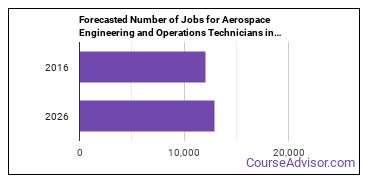
The states with the most job growth for Aerospace Engineering or Operations Technician are Utah, Georgia, and Alabama. Watch out if you plan on working in Washington, Kansas, or North Dakota. These states have the worst job growth for this type of profession.
Average Aerospace Engineering and Operations Technicians Salary
Aerospace Engineering and Operations Technicians make between $42,610 and $100,310 a year.
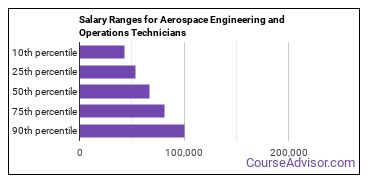
Aerospace Engineering and Operations Technicians who work in Washington, Colorado, or Missouri, make the highest salaries.
How much do Aerospace Engineering and Operations Technicians make in different U.S. states?
| State | Annual Mean Salary |
|---|---|
| Alabama | $60,630 |
| Arizona | $71,500 |
| California | $68,410 |
| Colorado | $84,190 |
| Connecticut | $65,330 |
| Florida | $62,050 |
| Georgia | $50,930 |
| Illinois | $58,500 |
| Iowa | $57,170 |
| Kansas | $66,870 |
| Maryland | $71,760 |
| Missouri | $76,630 |
| New Jersey | $67,780 |
| New Mexico | $73,570 |
| New York | $75,070 |
| Ohio | $67,210 |
| Oklahoma | $66,120 |
| Oregon | $65,440 |
| Tennessee | $68,440 |
| Texas | $66,960 |
| Utah | $62,060 |
| Virginia | $75,060 |
| Washington | $93,740 |
What Tools do Aerospace Engineering and Operations Technicians Use?
Although they’re not necessarily needed for all jobs, the following technologies are used by many Aerospace Engineering and Operations Technicians:
- Microsoft Excel
- Microsoft Word
- Microsoft Office
- JavaScript
- Microsoft PowerPoint
- Python
- Microsoft Access
- Word processing software
- Microsoft Project
- Autodesk AutoCAD
- Microsoft Visio
- Microsoft SharePoint
- Structured query language SQL
- Linux
- Extensible markup language XML
- UNIX
- Microsoft SQL Server
- Computer aided design CAD software
- National Instruments LabVIEW
- Dassault Systemes CATIA
Becoming an Aerospace Engineering or Operations Technician
Individuals working as an Aerospace Engineering or Operations Technician have obtained the following education levels:
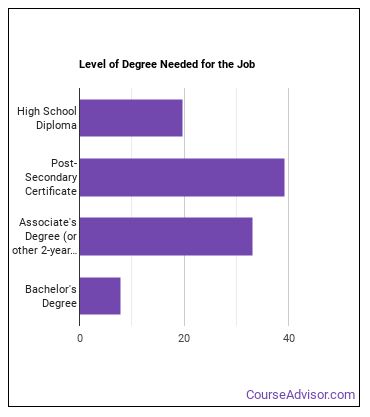
What work experience do I need to become an Aerospace Engineering or Operations Technician?
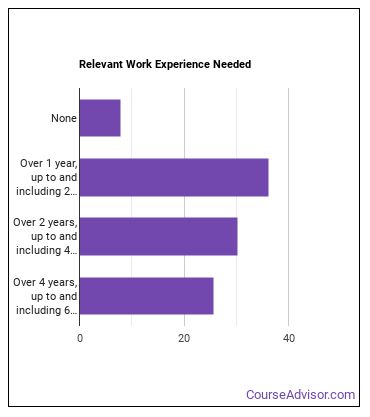
Who Employs Aerospace Engineering and Operations Technicians?
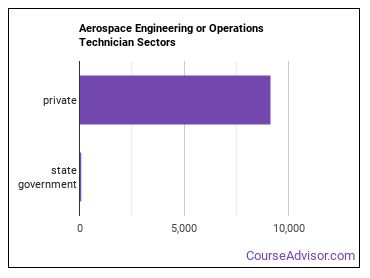
The table below shows the approximate number of Aerospace Engineering and Operations Technicians employed by various industries.

References:
Image Credit:
More about our data sources and methodologies.
Featured Schools
 Request Info
Request Info
|
Southern New Hampshire University You have goals. Southern New Hampshire University can help you get there. Whether you need a bachelor's degree to get into a career or want a master's degree to move up in your current career, SNHU has an online program for you. Find your degree from over 200 online programs. Learn More > |
